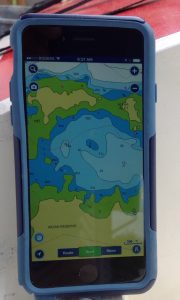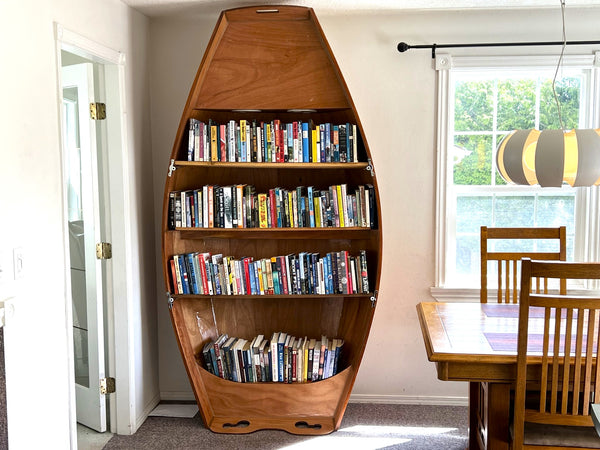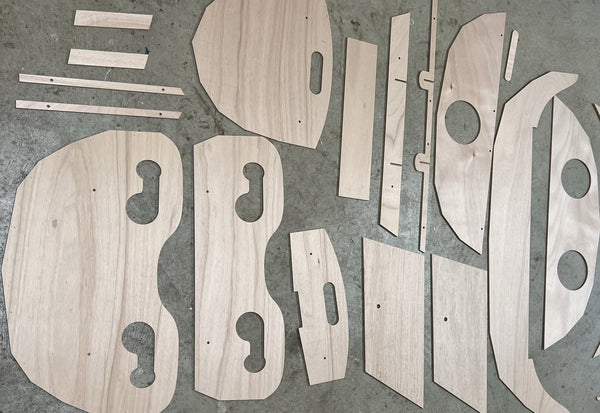Navionics - The New Way to Navigate in Small Boats
 There is an array of electronic devices that can be used in small boats for navigation. Until recently, the handheld GPS has been our primary choice. While a plotter GPS is a great tool, it is typically not practical in small human powered boats due to its weight and electrical requirements.
There is an array of electronic devices that can be used in small boats for navigation. Until recently, the handheld GPS has been our primary choice. While a plotter GPS is a great tool, it is typically not practical in small human powered boats due to its weight and electrical requirements.
In the last few years a new option has arisen using a smart phone along with the variety of navigation aps available. Modern smart phones have an internal GPS that allow them to work in conjunction with externally sourced software. At first I was skeptical of using a phone, instead preferring the simplicity and water resistance of a handheld GPS. Prior to entering the 1200 km Race to Alaska, however, I began experimenting with the Navionics app partnered with my IPhone, and it wasn’t long before I was fully sold.
Standard handheld GPS’s simply don’t have the user-friendly interface of a smart phone or tablet, nor does the software come anywhere close to what is available for smartphones. Additionally, smart device screens are much larger than handheld GPS’s, making it much easier to decipher the charts. Navionics in particular is a program that offers unparalleled functionality for navigation. Routes can be plotted in seconds, the vector-based charts can be zoomed in and out instantly to give micro and macro perspectives, and tidal and current information is also displayed. You don’t need phone reception – the charts and tide information can be downloaded, so it works off the grid. Total cost for the app, which includes being able to download charts, is only $14.99 – worth every penny. You will also need to get a waterproof case for your device.
After a few days of using Navionics on my Iphone, there was no going back to my unwieldy handheld GPS. The functionality and capability of this combination is simply unrivalled. There are a few disadvantages to using a smartphone, however, that need to be overcome. Below we list some of the challenges faced, and how to deal with them.
Power Consumption
An IPhone with the screen on permanently and its internal GPS chip being used consumes a lot of power. An Iphone being used as a GPS will typically run out of power after about three hours of continuous use. A handheld GPS, on the other hand, will work continuously for 12+ hours, at which point the disposable batteries can easily be replaced. A smartphone requires recharging, which can be a challenging process in a boat. Additionally, even with a waterproof case the charging terminal is vulnerable to water penetration, as there is (at this point) no waterproof case that provides waterproof integrity while being charged.
The simplest way to increase the phone’s power supply is to use a waterproof case with a built in battery that augments the phone’s battery such as the Juice Pack . This typically doubles the phone’s run time, and the phone doesn’t need to come out of the case to utilize the external battery. For longer voyaging, it may be necessary to charge the phone using an external charging battery. There are many options for doing this including the Poseidon Pack. One thing to keep in mind while charging with an external charger is the charging terminal is vulnerable to water and the phone needs to be kept in a dry location.
Overheating
A lot of heat is generated by full-time use of the GPS chip and constant screen time. When the unit is sitting in the sun it is prone to overheating (as my Iphone would do), and the screen will shut down to prevent damage from overheating. To prevent this from happening, keep the unit in the shade, or angle it so the sun isn’t shining directly on the screen.
Touch Screen Functionality Compromised When Wet
When the screen (of the waterproof casing) is wet from rain or spray touch functionality becomes compromised. It still works, however, it can be quite frustrating trying to operate your smartphone. Try to keep the phone in a dry location, and have dry rags or paper towel on hand if precise functionality is required in rough/wet conditions.
Summary
While there are some challenges to deal with when using a smart device for navigation, it is still worth it. Safe navigation relies on having a continual feed of information including location, currents, tides, etc., and a smart device with appropriate software is arguably the most effective way of remaining updated. The primary navigation device for Mad Dog Racing, the fastest boat in this year’s Race to Alaska was a tablet running Navionics. When sailing at 25 knots at night through BC’s constricted current-addled rocky passages it’s essential to have the best navigation equipment at your fingertips. Navionics can be downloaded from Itunes here.Leave a comment
Comments will be approved before showing up.
Also in News

Human Powered Achievements through the Northwest Passage
At Angus Rowboats, our passion for adventure naturally draws us to the mystique of the Northwest Passage – one of the world's most captivating and perilous waterways. Historically, this elusive passage promised a shorter shipping route, spurring early navigators to fervently chart and struggle through its icy intricacies.
The summer of 2023 saw three audacious teams, including one using our very own RowCruiser boats, aiming to be the first to traverse NW Passage solely by human power within a single season. As the season concludes, we've chronicled these attempts, and catalogued past human-powered endeavors to navigate the Northwest Passage.

Creating a Bookcase from a Boat


Colin Angus
Author